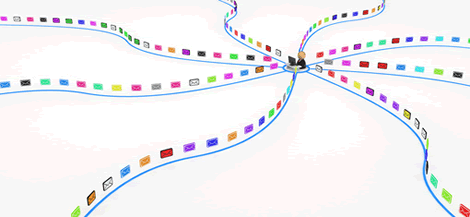- POPULAR ARTICLES
- Thank You Words
- Retirement Wishes
- Face to Face
Technology and Human Communication
Email Shifts
Email Technology and Human Communication in the workplace have undergone shifts that can't be reversed.
The three mayor shifts began when email became widely adopted in the corporate world in the early 80s.
Organizations embraced email as a productivity tool. At that time, email was text based and somewhat local to a specific campus. As networking technology evolved, email expanded its reach.
Email filled a need for faster communication. Up until then, people relied on face to face communication, letters, and the telephone to communicate with others, whether at work or in their personal lives.
Email became an inexpensive alternative to connect with others, regardless of location. As a result, people transformed the way they communicated with others, mostly by increasing the frequency of their contact.
Email Technology and Human Communication - Three Irreversible Shifts
1. Communication Control Shift
Before email adoption, employees stuck to the chain of command as communication channel. Downward communication: Orders, directives and information flowed down. Upward communication: Reports, statuses, complaints and requests flowed up, through the formal chain of command.
When email became available to all employees in an organization, people started forwarding and copying other people in unexpected ways: their boss's boss, bosses in other departments or other companies altogether.
An initial reaction was for managers to remind employees to stick to the chain of command. But a shift in communication control had occurred and couldn't be reversed. Communication in the organization became more fluid and open.
2. Sorting out Email Importance Shifts from Receiver to Sender.
Before email, people had to type, print, sign, make copies, address envelopes, put stamps when needed and mail everything to intended recipients, sorted alphabetically or by rank. Some of us even highlighted the names on the cc: list to somewhat personalize the mail experience.
As a sender, you were selective on what messages needed to go on a memo or letter. When something was put in writing, it meant it was important.

To send a message using email, all you have to do is type it in the computer, type the distribution list and click the send button. Voilà, you've instantly reached all your intended recipients in minutes.
With email, senders stopped fretting over the importance of a memo before they sent it out. Recipients were now left with the charge of sorting out their email inboxes and figure out what messages were important.
3. Shift from face to face to email communication.
 Nowadays people use email to communicate with others even when they are a few steps away from them. Email is convenient and lends itself well for quick one way communication.
Nowadays people use email to communicate with others even when they are a few steps away from them. Email is convenient and lends itself well for quick one way communication.
People may even prefer not having to go through all the pleasantries the are called for when communicating in-person.
To sum up
Email technology has irreversible changed human communication in the workplace. (1) People communicate more openly, (2)senders don't filter what they send by their level of importance and (3) face time is dwindling.
A related article about effective email communication




